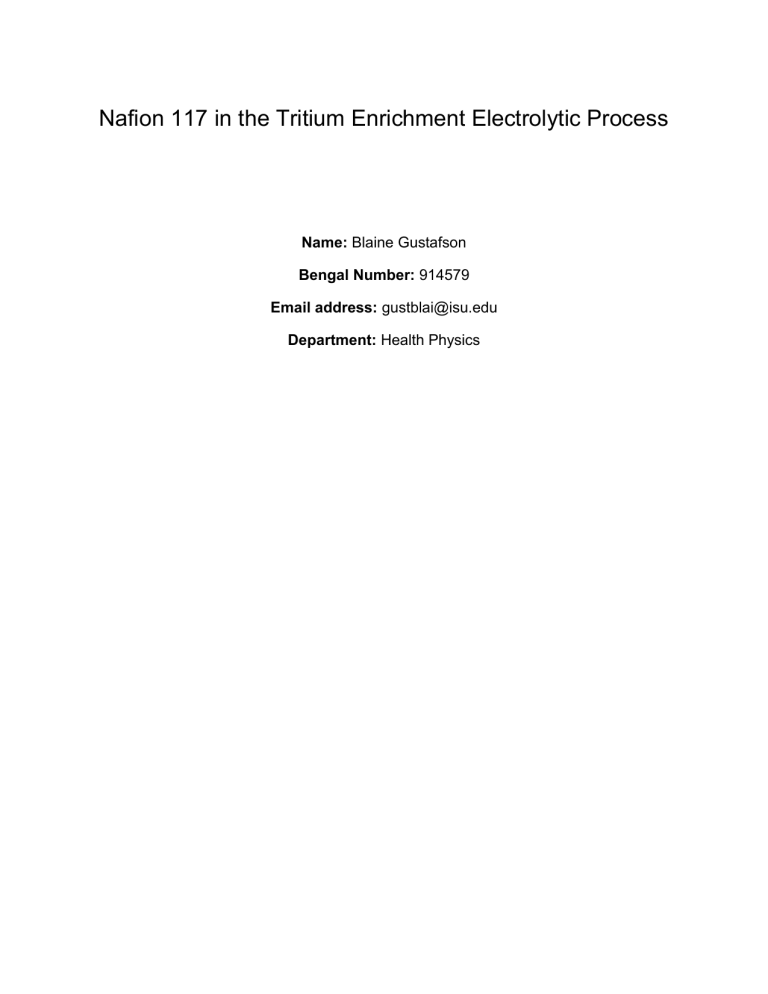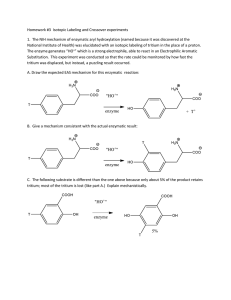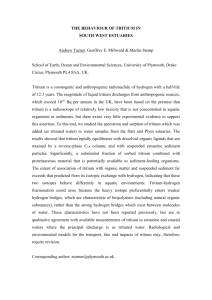
Nafion 117 in the Tritium Enrichment Electrolytic Process Name: Blaine Gustafson Bengal Number: 914579 Email address: gustblai@isu.edu Department: Health Physics Introduction The focus of this research is to examine the viability of a solid polymer electrolytic film (SPE) called Nafion 117 in the tritium enrichment electrolysis process. The tritium in water samples must be concentrated through an electrolytic enrichment process to attain a measurable level for liquid scintillation counting. This is typically done using two methods. The first method uses an electrolyte dissolved in water such as sodium hydroxide (NaOH) to act as a conductor between the cathode and anode of the electrode. The second method uses a solid polymer electrolyte (SPE) film to act as the conductor between the cathode and anode of the electrode. No dissolved electrolyte is used in the second method. In both methods, a volume of a water sample is contained in a cell with an electrode inside the water. The different electrodes are connected in series and connected to a power supply. A current is run through the electrodes to separate the water into hydrogen and oxygen. A benefit of the first method is simplicity. A drawback of this first method is the sodium hydroxide remains in the water. A vacuum distillation process can be used to separate the water from the sodium hydroxide. A benefit of the second method is that no dissolved electrolyte is required. A drawback of this method is the SPE film can degrade over continued use. My null hypothesis states the Nafion 117 SPE film cannot be used in the electrolytic enrichment process. My alternative hypothesis states the Nafion 117 SPE film can be used in the electrolytic enrichment process. I will be using the Quantulus 1220 liquid scintillation counter to measure the tritium levels in the water samples. Literature Review The SPE electrolytic process was first used by Saito, M. et al.(Muranaka, 2012). Using SPE film in the electrolytic process are generally classified into two types. The first is an oxygen-hydrogen separating type and the second is an oxygen-hydrogen non-separating type. The first is useful and quick with a large current and is commercially available. The second has a higher recovery factor. (Muranaka, 2012). To determine the tritium enrichment factor the tritium recovery factor is used, R=(Tf✕Vf)/(Ti✕Vi). Tf and Ti represent the tritium concentration before and after the tritium enrichment while Vf and Vi represent the volume of the water sample before and after the enrichment. (Muranaka, 2012). “Membrane selectivity has become one of the key factors of electrolysis processes with a high production capacity.” (Paidar 2016). “Platinum metal-based electrocatalysts represent the state-of-the-art in this field due to their long-term corrosion resistance.” (Paidar 2016). A major drawback of using platinum is its high cost. Graphite is another electrocatalyst that can be used. Graphite is an inexpensive conductor compared to platinum . One drawback for graphite is that graphite does not have long-term resistance platinum does. “One of the main concerns for the adoption of Polymer Electrolyte Membrane Electrolyzer (PEME) systems for use in tritium isotope separation is the degradation of the Nafion® (DuPont) polymer due to the beta radiation produced by the decay of tritium. Tritium decay gives off beta radiation that has a relatively low average decay energy of 5.69 keV.” (Fox 2009). Materials and Methods The materials in this research will consist of glass cells containing the water samples placed in a water bath cooled to around 5 C. The electrodes consist of an iron anode plate and a non-ferrous metal cathode plate connected in series to a power supply. The SPE film will rest between the anode and cathode of the electrodes. Wire mesh will separate the contact surface between the metal plates and the SPE film. A graphite plate will fit between the wire mesh and the SPE. The normal voltages used in the tritium enrichment electrolysis process at Idaho State University are 0.3 V and 3.0 V. Various voltages can be tried to determine the optimal voltage. Quantulus 1220 The tritium enriched samples will be analyzed using the Quantulus 1220 liquid scintillation detector to measure the tritium levels in each water sample. The Quantulus is an ultra low level counter for Tritium and Carbon-14. Quantulus unilizes a concept known as total optimization. Total optimization enhances the accuracy of low level counting and considers all the factors that affect the counting. (PerkinElmer). Optimization is achieved by using multiple multichannel analyzers (MCA) technology and background reduction. The Quantulus 1220 has a patented technology called the “automatic Continuous Spectrum Stabilizer” that results in high stability in counting the samples. The Quantulus has a passive shield and active shield. (PerkinElmer). The passive blocks cosmic rays. The photomultiplier tubes fit into the active shield. (PerkinElmer). The variable counting method the Quantulus utilizes consists of three sample trays. Each sample tray can hold up to 20 liquid scintillation vials. The Quantulus can count up to 60 samples at any given time. The variable counting allows one entire tray to be counted, certain positions in a tray, or samples in different trays and different positions. (PerkinElmer). References: Muranaka, Takeshi and Shima, Nagayoshi (2012). Electrolytic Enrichment of Tritium in Water Using SPE Film. InTechOpen. Paidar, M. Fateev, V. Bouzek, K. (2016). Membrane electrolysis—History, current status and perspective. ElsevierElectrochimica Acta. Volume 209. 737-756. Fox, E. B. Greenway, S. D. Clark, E. A. (2009). Radiation Stability of Nafion Membranes used for Isotope Separation by Proton Exchange Membrane Electrolysis. Materials Science & Technology Savannah River National Laboratory. Saito, Masaaki. Imaizumi, Hirosh, Kato, Norio, Ishii, Yoshiyuki, Sekiya, Kiyoshi. (2009). Comparison between Anode Side and Cathode Side for Tritium Enrichment of Solid Polymer Electrolysis. Tokyo Metropolitan Industrial Technology Research Institute Komazawa Lab. Department of Chemical Engineering, Faculty of Engineering, Niigata University. Faculty of Health Science, Ehime Prefectural University of Health Science Institute of Low Temperature Science, Hokkaido University. PerkinElmer. Wallac 1220 Quantulus. Ultra Low Level Liquid Scintillation Spectrometer. PerkinsElmer Life Sciences.. Turku, Finland. Pawlyta, Jacek. Pazdur, Anna. Rakowski, Andrzej. Miller, Brian F. Harkness, Douglas D. (1998) Commissioning of a Quantulus 1220 liquid scintillation beta spectrometer for measuring 14C and 3H at natural abundance levels. ResearchGate. Institute of Physics, Silesian Technical University, Krzywoustego 2, PL-44-100 Gliwice, Poland. NERC Radiocarbon Laboratory, NEL Technology Park, East Kilbride, Glasgow G75 OQU, Scotland



